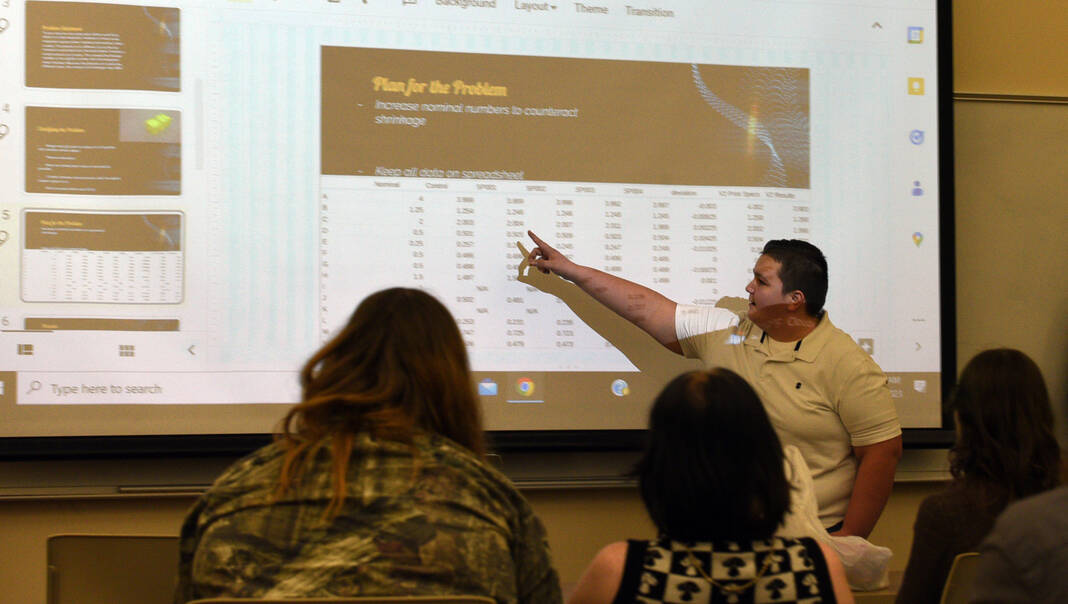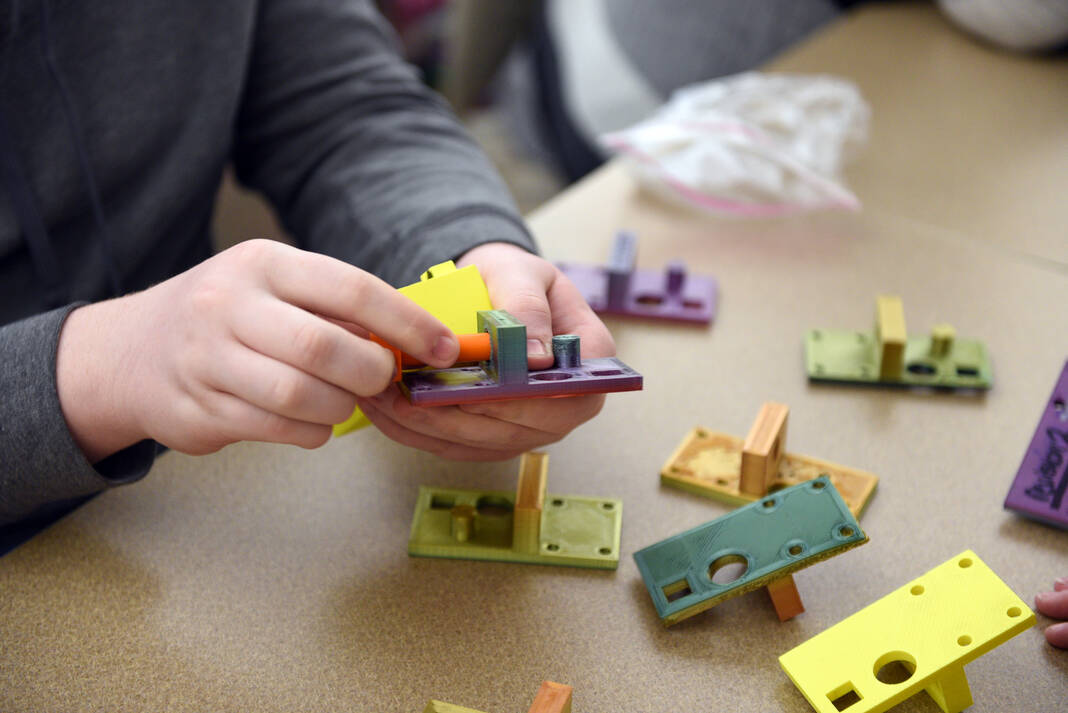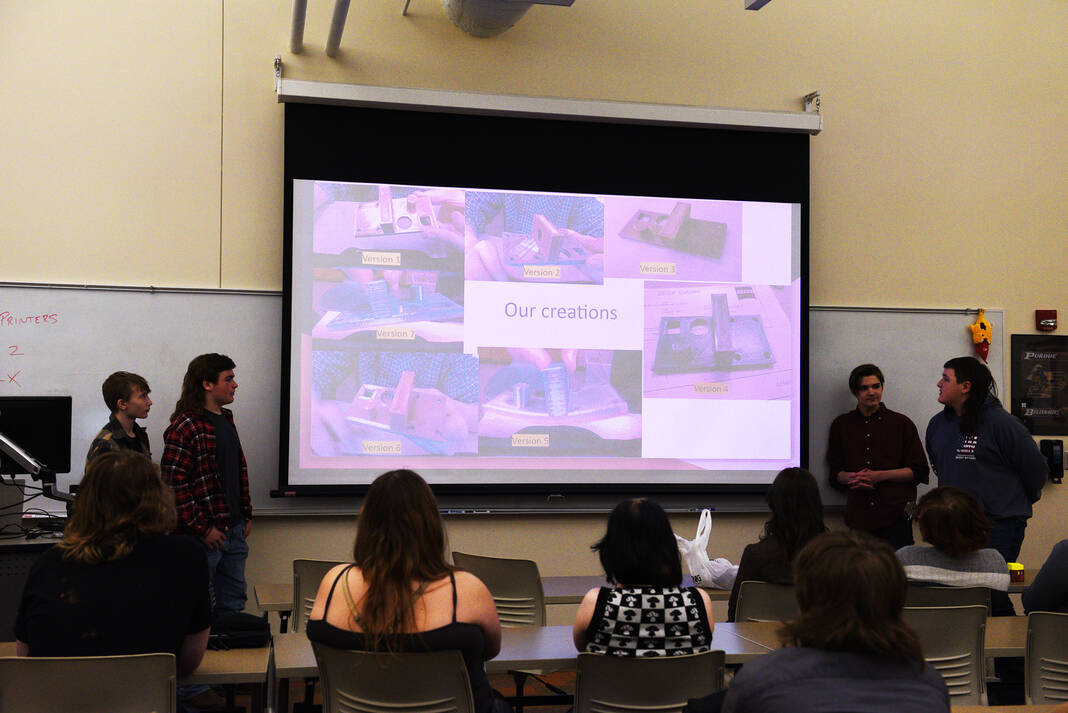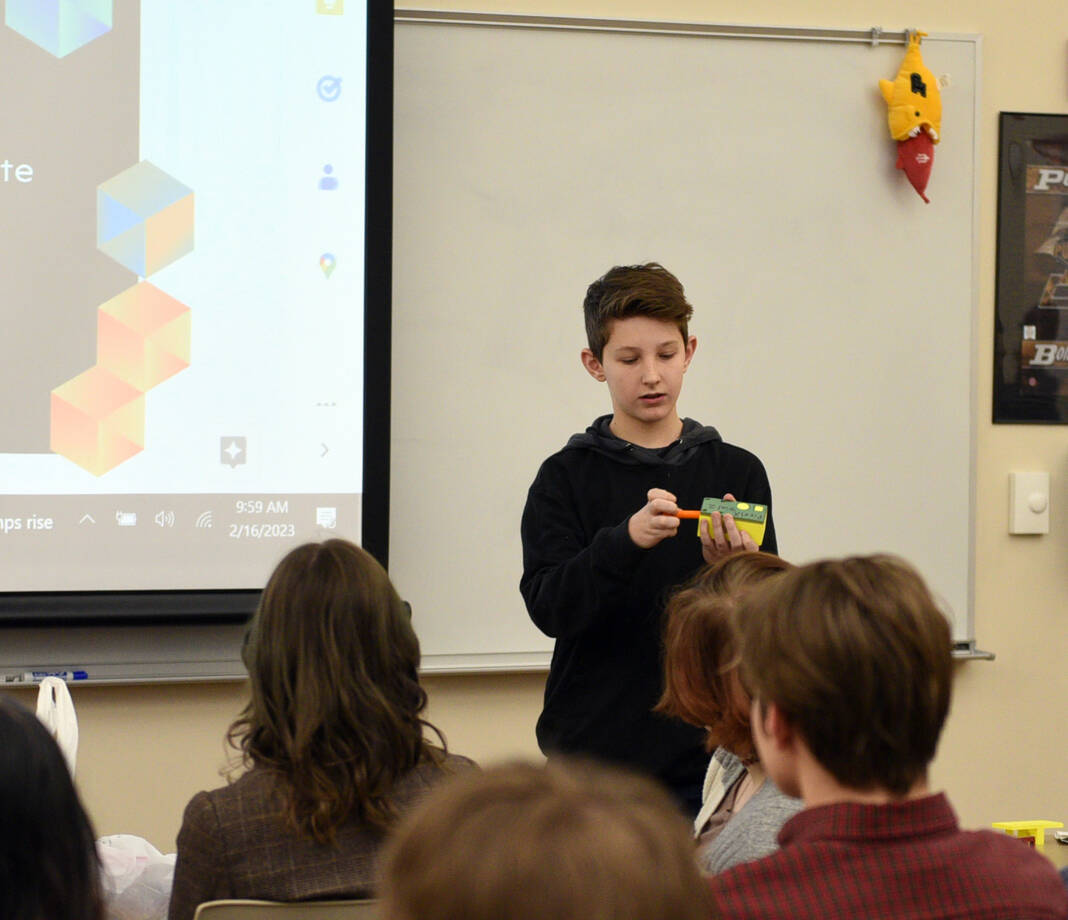
Brown County Middle School students had the opportunity to present at Purdue Polytechnic in Columbus on Feb. 16. The students are a part of the Corporate Problem Solving Challenge, which allows students to work with corporations to further their STEM abilities in real-world problem solving situations.
Abigail Youmans | The Democrat
Middle school students don’t often have the opportunity to present solutions to leading corporations, but thanks to the efforts of local teachers and stakeholders, Brown County Middle School students are learning skills that they will take with them into the professional world.
Five years ago, the Corporate Problem Solving Challenge was introduced to middle schoolers in Brown County, adding new opportunities in STEM (science, technology, math, engineering) for students.
In 2018 Brown County Middle School — formerly the junior high school — joined the other 59 schools in the state with a STEM certification.
There are now a total of 100 STEM-certified schools in the state, a certification through the Indiana Department of Education.
Some schools initially become certified as beginning- or emerging STEM-certified schools, but the middle school received its full certification on the first try in 2018.
The STEM journey at BCMS began a decade ago with the implementation of Project Lead the Way, which is an engineering- and technology-based curriculum. That was followed by the expansion of computer science courses and a focus on STEM-based instruction schoolwide.
One of the pieces to STEM certification is having technology at the foundation of classroom instruction.
Other parts of STEM certification include working with students on developing communication and other “soft skills,” along with providing career education.
In the Corporate Problems program, students are presented a problem from its community partners, corporations like Cummins, Forvia (formerly Faurecia), LHP Engineering Solutions, Columbus Regional Hospital and Purdue Polytechnic Institute.
Whether it’s the creation of an HHO generator for a 3.8-liter engine, designing functional parts on a 3-D printer or helping a hospital increase awareness of lack of emergency room beds, local students are tasked with developing solutions for the professional world.
Kevin Roush teaches science at the middle school and has been instructing Corporate Problems since its beginning in 2018.
“It’s an opportunity for them to see what real-world problem-solving is like,” Roush said.
Highly paid engineers, Roush said, are asking 8th graders go through the process to provide a solution to problems these companies often face.
Corporate problem can also lead to potential employment opportunities and contacts made for students.
They are learning “soft skills” too, like how to work in a group, how to communicate, and how to present in a professional setting.
Regardless of their skill level, Roush said students have worked extremely hard and are seeing their hard work pay off.
“I’ve seen students who are scared to death to talk in front of the class, scared to even answer a question in class, and I’ve seen them get up and present to a group of strangers with the confidence that they knew what they were doing and what they’re talking about,” Roush said.
“Their growth has been absolutely amazing.”
Someday down the road, these young men and women could be working for one of their community partners, Roush said.
“This is a great school, it’s a great opportunity for kids to make those connections in this community,” he said.
His class puts science on hold for seven or eight weeks and works on their problem at hand.
They start with how to give a presentation, being an audience during a presentation, they work with a mentor, learn technology and programming and more.
Roush said that through this in-depth process they want to make sure they appreciate the support the program receives from not only students and staff at the middle school, but also from their corporate partners and mentors.
From time commitments, buying lunch for groups, purchasing a 3-D printer — Roush said he can’t say “thank you” enough.
He also said it couldn’t be done without the help of Mark Stidham and Dave Redding, who he said are the “boots on the ground.”
“We have two of those who are so behind this project. It’s something that I hope we continue to do, I think it’s such a valuable experience that (the students) get,” he said.
Story continues below gallery
Poised for inspiration
Around the time that former BCMS principal Brian Garman was seeking STEM certification for the school, he contacted Dave Redding and Mark Stidham.
Redding was with Cummins at the time, and Stidham was semi-retired from Faurecia. Both were among a group of professionals organized by Garman that became a dynamic team, Redding said.
“The most common thing (between them) was that they cared about the next generation. (We) cared about the adults that would be leading these companies,” he said.
Knowing it was important to recruit corporate sponsors, Redding and Stidham stepped up to recruit additional corporate sponsors.
“You need an advocate in the school that believes in it, and an advocate outside of it as well,” Stidham said.
Redding is an amateur in Ham radio, he said, and with the help and encouragement of Garman introduced an after-school group for the technology at the middle school.
“I think this age group is very well positioned to be inspired,” he said.
“They’re at that age where they get the concept, they don’t clutter their dream up with all the details. Down at the sixth, seventh, eighth grade levels they’re going to hang onto that (experience) and it will be a positive reference point for later in life.”
After Garman left the school district, Stidham said he took a very active role in Corporate Problems.
“You need an advocate in the school, and outside of the school, which became Dave and me,” he said.
“The whole idea is these are real life problems that companies have, and in many cases the ideas that are generated from the teams do generate real life solutions in the company,” Stidham said.
One such instance was when Faurecia presented students two problems about two years ago.
The company tests exhaust systems in cars and trucks, and use separate batteries to run all the test equipment in the vehicles. Batteries should be charged, ready to use and functional.
This process often became a mess, Stidham said, batteries scattered all over the work area.
Students’ problem was to come up with a real system to organize the batteries, when they’re charged or not charged.
So students formulated solutions for the problem, which Faurecia went on to adopt.
“It was a solution the kids came up with and was implemented in the next year,” Stidham said.
Aside from the technical aspect, Redding said the presentation skills, teamwork and thought organization are all incredibly valuable life skills they are learning.
He said he has not only seen smiles of confidence among the students, but an understanding of STEM-related concepts develop in young minds.
“Eventually it clicks and you’re giving them something that not all other students or young adults their age know,” he said.
“That gives them a little bit of confidence that they’ve got something and they’re smarter for the experience.”
One young man, Redding said, had faced some challenges and ended up getting his amateur radio license.
Now he says he wants to get a PhD from Purdue in mechanical engineering.
“The smile on that kid’s face, the way he carried himself,” he said. “(It’s a) posture of confidence.”
Redding said he hopes that there is more confidence for young adults and more career path opportunities available to them than before they crossed paths.
“A confidence in themselves and seeing and knowing more options than they ever could’ve imagined for their futures,” he said.
Stidham said that presentations give students a feel for standing in front of an audience in a formal setting of about a dozen professionals.
The Faurecia problem to solve this year, he said, was trying to overcome the shortfalls of virtual reality (VR) used in a manufacturing process environment.
Faurecia uses VR to simulate building an exhaust system, which is what the company does.
However, in VR, users can’t sense the weight or size of an object.
Taking a group of students who may have used VR for fun, they now use it to address a problem.
“There were two or three teams that came up with things that really made you think,” Stidham said.
Corporate Problems is not autonomous either; it is intersectional, working across education departments.
“It’s not just the science class time that’s devoted to this, language arts gets involved in the presentations and format of presentations, teaching kids how to present, not to read from slides, to stand up in front of a crowd,” Stidham said.
“It’s ‘STEM,’ but there are problems outside of that. … The idea to bring it all together and show that your education makes sense in real life application.
“What do you do when a team member is not delivering? How do you work through those situations? Because it happens in real life. How do you organize your thoughts in a presentation? In the end these are consultants to the company. … They became the experts.”
Stidham said he hopes the program helps students feel more prepared for the next steps in life and that they’re also exposed to the real world.
“These are real problems. Every day, it’s ‘how do I deal with a problem today?’ Problem solving skills are really important,” he said.
He also hopes that the students’ interests are piqued in the founding facet of Corporate Problems, which is STEM.
“That’s what my hope is, that we trigger the imagination of the kids to a level where they may have the interest, in science or tech related fields,” he said.
‘Gaining skills’
The eighth graders working on corporate problems have gained a wealth of experience through their projects and presentations.
Roush said a large purpose of the program recognizes the background of students and challenges they may have faced, and helps them be able to stand up and present in front of a group, gain knowledge and confidence.
The Faurecia group was asked if they felt more prepared this year, Roush said, after having some practice the previous year.
“They said that they felt that this year’s project they were presenting with a purpose,” he said.
Gabby Dersch said that doing the research and learning about new topics was fun, too.
Ava Kinnett and Maggie Smoot were in the group that partnered with Columbus Regional Hospital, tasked with creating a public service awareness campaign about emergency room beds being taken up by those with substance use disorders.
“We had to make our guidelines, budget and everything,” Smoot said.
“My favorite part was the ending, working with a team, but mostly seeing what I accomplished and what I was capable of doing.”
Kinnett said that she gained people skills through the process.
“Usually I’m a perfectionist and like to do everything myself, but I was able to get with a group, let them do things, and we got together and did a really good thing,” she said.
You didn’t need any prior knowledge of your topic, Ryan Myers said, but you were able to learn new skills — like 3-D printing — along the way.
He was already familiar with some of the programming and software they used, since he’s involved in Eaglet Manufacturing, the student engineering lab at the middle school.
Myers’ group worked with Purdue Polytechnic Institute in Columbus and he enjoyed visiting the school and seeing how they do things.
Last trimester, Myers said his future plans included attending Ivy Tech Community College. Now, he wants to go to Purdue.
“I learned about Purdue, what they do and how they do things,” he said.
“I want to go there now.”
He may study chemical engineering, but right now he’s undecided.
It was intimidating at first, Myers said, being in a room of people that may know more about a topic and work at the corporation, trying to project a student voice and make the audience understand what they were trying to say.
For that experience, though, the students agreed that they feel more prepared for their futures.
“I feel like I’m more prepared for high school, but scared of it still,” Myers said.
Ethan Orr was also in the Purdue group, and said he’s ready for next steps in his future.
“I’m not even scared (for high school), I’m prepared for it,” he said.
Dersch was in the Cummins group, and was tasked with creating a piece for an oxyhydrogen (HHO) engine, to make the engine more efficient.
She said that their plan couldn’t be too small, too big, too far or too close — it had to be perfect.
“My group had to go through three different designs, none of them worked until the final one,” she said.
Dersch said she was not a group leader, but because of personnel changes in the company, it forced her to step up and take a leadership role in her group.
Students encouraged their fellow students and incomers to Corporate Problems to take it seriously.
Dersch said that she hears people say negative things about Brown County, but her own experience has brought positive opportunities.
“This gives everybody the opportunity to know what they want to do when they get older, and be more prepared for how life’s going to be,” she said.












